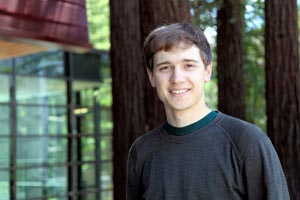Emerson Glassey was only 16 when he arrived on the UC Santa Cruz campus.
He'd finished high school in two years, gone to junior college, and begun looking for a university to attend. Despite a stack of applications, however, only UC Berkeley and UCSC accepted the teen. UCSC was his pick.
Other schools' rejections were UCSC's gain. The 19-year-old, who will graduate this year, is completing a project with UCSC Assistant Professor of Chemistry Roger Linington that may change the way researchers discover compounds in marine bacteria for use in the development of new drugs.
The biochemistry and molecular biology major, and bioinformatics minor, has his eye on research and teaching at a university some day.
Born in the tiny town of Willitts, Calif., Glassey came to love science thanks to his older siblings and a biology teacher at the charter high school he attended. By the time most kids were thinking about junior prom, Glassey was working in a lab run by Stanford Assistant Professor of Chemical Engineering Alexander Dunn. The lab was studying the rate at which collagen is snipped by enzymes when it is stretched. The research had implications for cancer metastasis and embryo development — and netted Glassey's name on a paper published by the Journal of the American Chemical Society.
He was 18.
But it is his work with Linington at UCSC that most excites Glassey. Collaborating with graduate student Kenji Kurita, Glassey wrote a software program that rapidly analyzes compounds produced by bacteria.
Instead of taking months to identify new compounds in these bacteria and find out how these compounds affect cells, this new analysis tool requires only minutes to do the same work. It could have far-reaching implications for the development of new drugs from natural products.
But the beauty of the program, which uses classical probabilistic models and vector manipulation, is that it is not limited to natural products research. It can be used to compare and find correlations between almost any two data sets.
Glassey plans to work in Linington's lab for one more year before going to graduate school and pursuing a career in research.
"I found what I enjoy, and what I'm proficient at," he said.
Winner of the prestigious Bunnett Undergraduate Research Award, Glassey is not only a member of UCSC's bike-racing team but also a fan of posting YouTube videos featuring slime mold and combustible compounds, fodder for any budding scientist — and a hit with his younger relatives.



